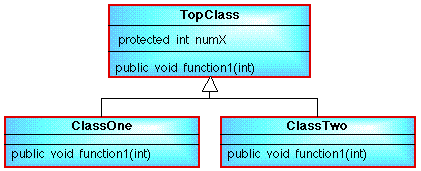1. INTRODUCTION
Consider the class hierarchy given in Table 1. Here we have a TopClass which has a constructor and a field numX. This class has two subclasses, ClassOne and ClassTwo, both of which have a method called function1 whose signatures (heads) are identical but whose bodies differ --- one divides numX by 2 and the other by 3. Figure 1 presents a class diagram illustrating the class hierarchy associated with these classes.

Figure 1: Class hierarchy.
An application class which makes use of the classes in the hierarchy is presented in Table 2, together with some sample output in Table 3.
// Abstract Example application
// Frans Coenen
// 9 March 2000
// Dept Computer Science, University of Liverpool
class AbstractExApp {
// ------------------ METHODS ------------------------
/* Main method */
public static void main(String[] args) {
// Create instance of ClassOne and ClassTwo
TopClass topObject = new TopClass(24);
ClassOne object1 = new ClassOne(12);
ClassTwo object2 = new ClassTwo(6);
// Output
System.out.println("topObject.getNumX() = " +
topObject.getNumX() + "\n");
object1.function1(2);
System.out.println("object1.getNumX() " + "
(after object1.function1(2) call) = " +
object1.getNumX() + "\n");
object2.function1(2);
System.out.println("object2.getNumX() " +
"(after object2.function1(2) call) = " +
object2.getNumX() + "\n");
}
}
|
Table 2: Application class
$ java AbstractExApp topObject.getNumX() = 24 object1.getNumX() (after object1.function1(2) call) = 14 object2.getNumX() (after object2.function1(2) call) = 12 |
Table 3: Output
// Abstract Example Classes - ClassOne
// Frans Coenen
// 10 March 2000
// Dept Computer Science, University of Liverpool
class TopClass {
// ----------- FEILDS ----------
protected int numX;
// ----------- CONSTRCTURS ----------
public TopClass(int value) {
numX = value;
}
// ----------- METHODS ----------
/* Get numX */
public int getNumX() {
return(numX);
}
}
class ClassOne extends TopClass {
// ---------- CONSTRCUTORS ----------
public ClassOne(int value) {
super(value);
}
// ----------- METHODS ----------
/* Function 1 */
public void function1(int numY) {
numX = numX+numY;
}
}
class ClassTwo extends TopClass {
// ---------- CONSTRCUTORS ----------
public ClassTwo(int value) {
super(value);
}
// ------------ METHODS -------------
/* Function 1 */
public void function1(int numZ) {
numX = numX*numZ;
}
}
|
Table 1: Class hierarchy